Cortex-A8 SoC integrates e-reader controller
Mar 1, 2010 — by Eric Brown — from the LinuxDevices Archive — 65 viewsFreescale Semiconductor announced an ARM Cortex-A8 system-on-chip aimed at e-readers, along with a Linux- and Android-compatible reference design. The i.MX508 integrates an 800MHz Cortex-A8 core with a display controller from E Ink, improving performance, screen resolution, and battery life, while halving cost compared to earlier i.MX-based e-reader designs, says the company.
In October, Freescale announced an agreement with E Ink Corp. to integrate the latter's Vizplex electrophorescent (EPD) monochrome display controller in forthcoming i.MX system-on-chips (SoCs). In November, E Ink announced a somewhat similar deal with Marvell to incorporate a Vizplex EPD controller in Marvell's Armada 166E SoC. (The Armada 166E is built into the new Alex e-reader from Spring Design, and Entourage Systems' Entourage Edge, both of which run Android.)
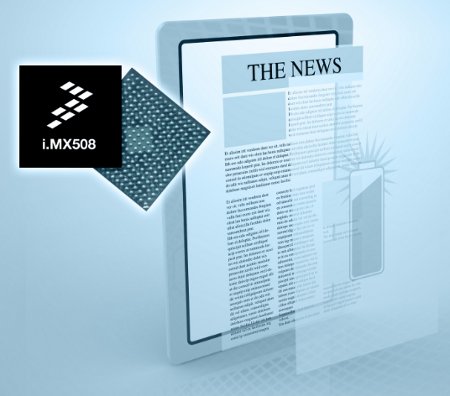
The i.MX508 supports larger, higher resolution e-reader displays.
The i.MX508 is not a member of Freescale's previous Cortex-A8-based i.MX51 SoC family, which targets netbooks and smartbooks with its i.MX515 model, and is also available in industrial and automotive versions. However, it's close enough that Freescale is offering the i.MX51 as an early stand-in for its i.MX508 e-reader reference design (see farther below).
Whereas the i.MX515 clocks its Cortex-A8 from 600MHz to 1GHz, the i.MX508 runs at 800MHz. Equipped with the same 256KB of L2 cache, the SoC is available in a similar 65nm-fabricated, 13 x 13mm (0.5mm pitch) package.
The i.MX508 provides twice the rendering performance of e-readers based on earlier Freescale i.MX processors, "resulting in faster page turns and snappy responsiveness for consumers," says Freescale. Here, Freescale refers to 2D rendering, not 3D — like the i.MX51, the i.MX508 offers support for OpenVG 1.1, which accelerates Flash and other multimedia, but it lacks the i.MX51's OpenGL ES 2.0 support for 3D, as well as its elaborate image processing unit. (Neither was needed, since E Ink displays cannot refresh fast enough to display video or animation.)
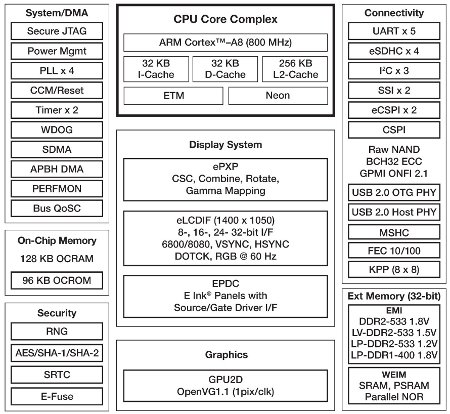
i.MX508 block diagram
(Click to enlarge)
Unlike the i.MX51, however, the i.MX508 offers more on-chip memory, plus support for faster system memory types, including LP-DDR2 for low-power applications, says Freescale. In addition, the SoC supports low-cost raw NAND memory with up to 32-bit ECC and an ONFI2.1/Toggle, which can help OEMs save $1 to $3 per unit, says Freescale. The SoC also supplies managed NAND Flash support with eMMC 4.4/SDIO, says the company.
I/O support is generally similar, offering dual USB PHY, including OTG and Host modes, as well as I2C, SSI, and CPSI. The i/MX508 appears to lack Ethernet support, however. (See block diagram above, and compare to the i.MX51 diagram here.)
Of course, the biggest difference with the i.MX508 is the presence of the E Ink Vizplex controller. The display controller appears to offer the same functionality as the separate, low-cost Epson S1D13522, jointly developed by E Ink and Epson, which started sampling in October. (That 10 x 10mm S1D13522 chip was said to cost $20 in sample quantities, include 2MB of embedded memory, and improve on previous EPD controllers by including onboard touch/pen support.)
Advanced touch, higher resolutions — and color?
The increased processing capability of the i.MX508 makes it easier to add "advanced touch solutions" and offer "other value added applications," says Freescale. In addition, the i.MX508 can support panel resolutions up to 2048 x 1536 at 106Hz, displayed in larger screen sizes than were possible with previous i.MX-based e-readers, says the company.
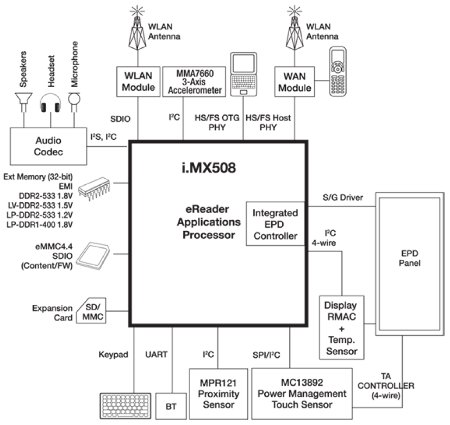
i.MX508 in typical e-reader design
(Click to enlarge)
The i.MX508 is designed to work with Freescale's MC13892 power management integrated circuit, which also addresses user interface and control, says the company. In addition, Freescale recommends that the i.MX508 be paired with its SGTL5000 stereo codec with headphone amp for audio coder/decoder functions, as well as its MMA8450Q low-power, 12-bit, 3-axis accelerometer.
Interestingly, Freescale notes that the i.MX508 "has the potential performance to quickly handle complex image manipulations and color processing." It is unclear whether this means that the i.MX508's next-generation E Ink controller offers color support, or whether a secondary color display controller might be integrated in future designs.
So far, e-readers that have supported both monochrome and color have required a separate color display, as seen in the Alex, Entourage Edge, and Barnes & Noble Nook. When we interviewed Glen Burchers, director of global consumer segment marketing for Freescale, in conjunction with Freescale's announcement of its Smartbook Reference Design in early January, he doubted that such dual-display devices would have much traction in the e-reader market, primarily due to greater cost.
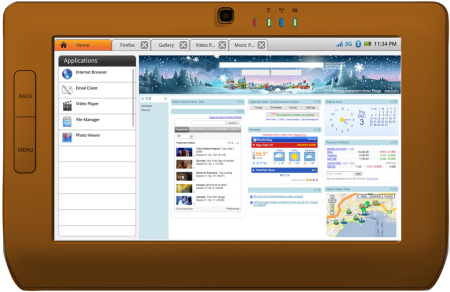
Freescale's i.MX515-based Smartbook Reference Design
Reference design taps i.MX51 platform
The i.MX508 will support Linux, Android, and Windows CE, with support for each "phased in as they are ready," according to a Freescale spokesperson. Although the i.MX508 will not sample until the third quarter, developers can get started using a new SABRE (Smart Application Blueprint for Rapid Engineering) i.MX51 eReader Reference Design that uses the software version of the E Ink EPD controller, said the spokesperson. Users can even "go to production with the i.MX51 if they want, and then easily move their software to the i.MX508 when it becomes available."
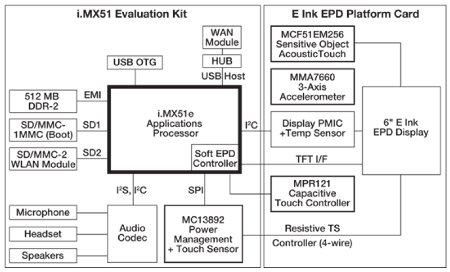
SABRE i.MX51 eReader Reference Design block diagram
(Click to enlarge)
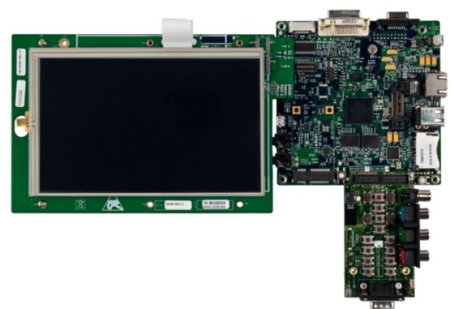
i.MX51 evaluation kit
Freescale: We own 90 percent of e-reader market
Freescale cites DisplaySearch as forecasting that e-reader device shipments this year will be triple that of 2009, increasing to over 14 million units. E Ink's Vizplex controllers ship in most e-book readers on the market today, including the market-leading Amazon Kindle, the Sony Reader, and the Irex iLiad, all of which run Linux on an i.MX processor. 
Freescale owns a greater than 90 percent market share in applications processors shipped in e-readers, claims the company. The Kindle and the new Irex DR800SG run on an ARM11-based i.MX31 processor. Other SoCs recommended by Freescale for e-readers include the ARM9-based i.MX233 and i.MX257, the ARM11-based i.MX353, and now, with the new SABRE kit, the Cortex-A8-based i.MX515.
Stated Bernd Lienhard, VP and GM of Freescale's Multimedia Applications Division, "Working closely with E Ink and our customers, we are able to offer an integrated silicon solution that facilitates lower eReader retail prices and enables the next phase of growth in the eBook market."
Stated Sriram Peruvemba, VP of marketing for E Ink, "The integration of the ePaper display controller into the newest i.MX processor will help lower costs while enabling the next generation of E Ink display based eReaders — a great combination for customers."
Availability
The i.MX508 applications processor is expected to cost less than $10 in quantities greater than 250K units, and begin sampling to select customers early in the third quarter, says Freescale. The SABRE i.MX51 eReader Reference Design with E Ink Vizplex software extensions is available now for $1,995. More information may be found here.
This article was originally published on LinuxDevices.com and has been donated to the open source community by QuinStreet Inc. Please visit LinuxToday.com for up-to-date news and articles about Linux and open source.